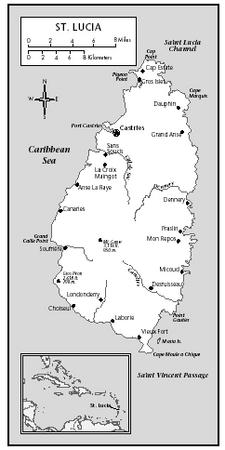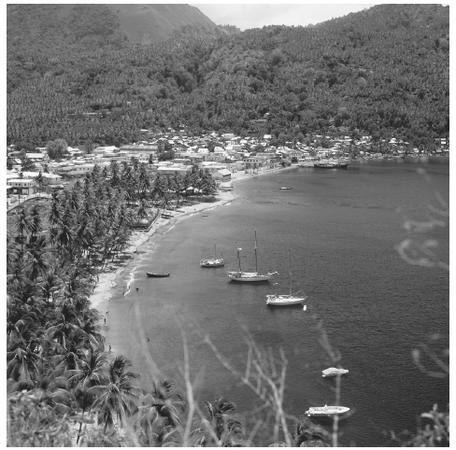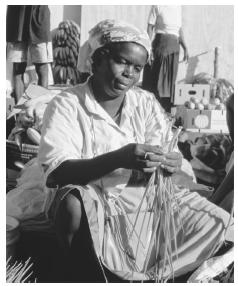Culture of Saint Lucia

Culture Name
Saint Lucian
Alternative Names
Hewanorra, Iounaloa (Island Carib)
Orientation
Identification. The origins of the name Saint Lucia are lost in history. The commonly held notion that Columbus sighted the island on Saint Lucy's Day, 13 December 1498, is dubious, for there is no good evidence of his "discovery." A more plausible explanation attributes the naming to one of various French visitors during the sixteenth century. It appears that the original designation was "Sainte Alousie," the name used in Father DuTetre's 1664 volume on the Antilles.
Saint Lucians identify by this name, distinguishing themselves from residents and nationals of neighboring islands. Although many thousands have emigrated to various parts of the Americas and Europe, especially during the twentieth century, this identification remains strong, even among those born in the diaspora. The question of a shared culture is contentious, for Saint Lucians are divided along many lines, yet there is a sense of belonging to a place, a locality, of which they have a sense of possession. One compelling item of common culture might be Kwéyo`l or Patwa, the French-derived creole language spoken by most Saint Lucians. However, many born and raised abroad do not speak the language, and Saint Lucians also recognize that their Kwéyo`l is virtually identical to that spoken on Dominica and the French islands of Martinique and Guadeloupe.
Location and Geography. Saint Lucia has an area of 238 square miles (616 square kilometers). It is 27 miles (43 kilometer) long on its north-south axis and 14 miles (22 kilometer) at its widest east-west dimension. Saint Lucia lies between Saint Vincent to the south and Martinique to the north. It is a mountainous island born of ancient volcanic activity, some of which remains in the form of a sulphur springs area near the southwest coastal town of Soufriere. Rainfall is plentiful but variable, with heaviest precipitation in the mountainous interior and drier regions at the north and south extremities. There is also an annual wet-dry cycle, but it is not pronounced.
The island is ringed by a number of settlements, many of which had their origins as fishing villages and residential areas associated with plantations. The capital, Castries, is in the northwest. Castries is situated on a natural harbor that accounts for its preeminence from earliest colonial times. In recent decades there has been a substantial growth of some interior settlements associated with banana cultivation.
Demography. The 1991 census puts Saint Lucia's population at 133,308; the 1995 population estimate was 145,213. This represents a 17.5 percent increase since 1980, and a 33.6 percent increase since 1970. Population growth is slowed only by a substantial outward migration. Nearly 40 percent of the population lives in the greater Castries area, a percentage that did not change much in the 20 years between 1970 and 1991. However, the Castries population has shifted from the central city and its densely populated residential areas to more dispersed suburban neighborhoods as new housing has been built. The area of most rapid growth is the Gros-Islet region in the north of the island, the center of tourism development and upper middle-class and expatriate housing construction.
Most of the population, approximately 90 percent, is of African or African-mixed descent, reflecting Saint Lucia's history of slavery. A small minority, less than 10 percent, has East Indian ancestry—descendants of indentured workers brought to the island after 1858. This minority has dispersed in the

Saint Lucia
last forty years, but is still concentrated in a few rural villages. There remain a few old families of European origin, but there are no settlements of poor whites like those found in some neighboring islands. A more recently arrived Middle-Eastern population is mostly settled in the city.
Linguistic Affiliation. Most Saint Lucians are functionally bilingual, especially those under 40 years of age. The language most commonly spoken in village and rural areas is Kwéyo`l, a creole language that is a mixture of French and African languages. English is the language of instruction in the schools and the language used in business, governmental institutions, and most formal settings. Some older Saint Lucians, especially in rural areas, have only rudimentary skills in English.
The use of the two languages represents socioeconomic differences. Kwéyo`l, although spoken by nearly all Saint Lucians, was denigrated and its monolingual speakers disadvantaged until the emergence of a recent cultural movement which has sought to celebrate and restore dignity to Kwéyo`l. English remains the language of official Saint Lucia, but there is a concerted effort to establish Kwéyo`l as a second national language.
Symbolism. The language issue reflects the cultural struggle of a mini-state, only recently emerging from its colonial past, to define and identify itself. Until the 1970s most of what passed for national symbols in Saint Lucia were of European derivation. The large square in central Castries was named Columbus Square, and the cricket ground, Victoria Park. An annual event was held on Morne Fortune above Castries to recognize the recapture of the island from the French by English forces in 1796 (and incidentally, the reimposition of slavery).
With the establishment of constitutional independence in 1979, a movement to give recognition to local figures and cultural expression, and to redefine Saint Lucian identity, took on great significance. When the island attained internal self-government in 1967, some symbols of national status appeared—a flag, an anthem, and a crest. The central square has been renamed Derek Walcott Square for Saint Lucia's Nobel Laureate in literature, and the park is now called Mindoo Phillip Park after a legendary Saint Lucian cricketer. But the task of creation or recreation of national symbols and national identity is still in process, and is frequently controversial.
History and Ethnic Relations
Emergence of the Nation. Saint Lucia had a long colonial history under both French and British rule. During a turbulent period of the eighteenth century, the island changed hands fourteen times and was finally ceded to the British in 1814. British colonialism came to an end in 1979 after a succession of constitutional changes involving increasing degrees of self-rule and autonomy, especially after 1951. The African population was brought to the island as slaves, mostly during the last half of the 1700s. Saint Lucia's formal institutions are evidence of the European colonial heritage, but the vital folk culture is a product of the African population.
National Identity. The search for a national identity is ongoing. Independence for Saint Lucia, as for most of her neighbors only recently emerged from a profoundly colonial experience, has involved an examination of cultural traditions that were suppressed in the past. Because culture is conflated with class and color, this is sometimes a difficult exercise.
Ethnic Relations. Ethnic relations in Saint Lucia are a product of the economic history of the island. The virtual demise of the Amerindian population and the establishment of an export-driven plantation economy dependent on African slave labor determined the fundamental social formation. Colonial domination by a European minority over an enslaved African majority established the social dynamic. The basic black-white opposition is complicated by the addition of other populations: East Indians from the sub-continent arrived in the 1850s as indentured labor for the plantations, and more recently a small number of "Syrians," mostly Christian Lebanese, have settled in urban areas as merchants. Unlike some larger Caribbean societies where there have been serious political divisions along ethnic lines, Saint Lucian race relations mostly reflect a continuing black-white tension.
Urbanism, Architecture, and the Use of Space
In recent times urban-rural divisions have been reduced. The island is small enough that, with improvements in roads and the proliferation of motor vehicles, especially public transport mini-buses, the capital Castries and the southern urban center of Vieux-Fort are within easy reach from nearly all localities. The consequence is that many now live outside these centers but commute daily to jobs. The days of rural isolation have ended.
Architecture reflects changes in materials and styles over time. The graceful tropical house styles characteristically made of wood, with steep-pitched roofs with dormers, jalousied windows, and filigreed trim, typical of upper-class dwellings four decades ago, are now things of the past. Cinder block construction has become ubiquitous, resulting in houses that are heavy in appearance, hot in the tropical climate, and occasionally given to collapse in a hurricane. Some public buildings are in the old colonial style, resembling British municipal construction throughout the Empire, but a disastrous fire in Castries in 1947 reduced three-fourths of the town to rubble and most new construction was box-like and utilitarian. Newer public construction has followed the same pattern.
Private homes with sufficient space used to have a sitting room, used only on rare occasions. Family heirlooms such as china and tapestries were kept in sideboards there, to be displayed on special occasions. Many of these spaces have been given over to the television set in the last two decades, as Saint Lucians have moved leisure time indoors from the stoop and veranda where neighborhood gatherings once took place after dark. New private homes incorporate kitchens with electric appliances and full bathrooms, replacing backyard cook sheds and outdoor latrines. It should be noted that many Saint Lucians still live in quarters much sparer than these, an indication of a continuing serious housing problem; in 1991 the modal dwelling size was two rooms.
Food and Economy
Food in Daily Life. Food habits reflect the plantation past: the typical diet contains a lot of starches, animal protein content that varies by location, and until recently, little in the way of green vegetables. Starches include various kinds of yams, dasheen, eddos, bananas and plantains, sweet potatoes, and breadfruit. Most of these are boiled, served with some kind of stewed fish or meat, and accompanied by a sauce. Pepper ( capsicum ) sauce is always present at the table, as most dishes are not prepared spicy hot. Animal protein sources reflect the historical scarcity of this element: pork hocks, pig tail, chicken back, and saltfish (cod) have been staples. Imported processed foods have been available for decades, but more recently account for larger parts of many meals.
Food Customs at Ceremonial Occasions. Ceremonial observances are occasions for celebration and lavish food and drink consumption. Celebrations usually mark rites of passage in the lives of Saint Lucians—christenings, first communions, confirmations, weddings, and funerals—while calendrical events are not especially marked. A first communion celebration, for example, usually includes a significant outlay in food and drink for guests, who come from around the island. Hosts try to serve prestigious drinks—whiskey, brandy, gin, rum—and a sumptuous meal centered on meat—chicken for the poorest and as much as a side of beef for the more affluent. Everyone in attendance must leave satisfied, and one never can be sure how many might stop in.
Basic Economy. Throughout Saint Lucia's colonial and post-colonial history, agricultural production has been export-oriented. More than some of its neighbors, Saint Lucia has undergone a series of booms and busts. Agricultural production under colonial rule focused on sugar cane, only giving way to bananas as a principal cash crop in the 1950s. Cane was grown under a number of systems—plantation, sharecropping ( metayage ), and smallholder—reflecting changing market conditions and capital investment over time. The shift to bananas opened up the market for large numbers of rural small producers, and ushered in an era of prosperity that lasted from 1960 to the early 1990s.
The focus on commercial export-driven production has meant that agriculture for local consumption has suffered. Research and development of locally consumed foodstuffs has received scant attention, credit facilities for food production have been non-existent, and storage and preservation of local foods has never been on the agenda of economic planners. One recent consequence of this bias has been that imported foods, mass-produced in countries like the United States, have often been cheaper for consumers than locally-produced alternatives.
Land Tenure and Property. Saint Lucia still supports the institution known as "family land" ( té fami ). This is a tenure and transfer practice that exists outside the legal system, although it is partially supported by the old French legal system (the Napoleonic Code) which is still extant. Briefly, the principles of the system are these: land is held not individually, but communally by family members; transfer, when one dies intestate, is in undivided parcel to all descendants; sale is proscribed, that is, land is retained by the family; rights in land are inherited without legal division. Family land exists alongside individual tenure and land transfers are often accomplished through wills.
Commercial Activities. Much commercial activity is concerned with importing goods from industrial economies. Trading in locally produced goods is largely in foodstuffs. The Castries marketplace is a daily market established and regulated by government where vegetables, fruits, meat and fish are sold. The market also has an area where locally produced crafts and utility items are sold to tourists and local customers.
Major Industries. Industrial growth during the last thirty years has been largely in the area of export processing plants producing garments, electronics assembly, paper products, and leather goods. These employ local labor but are often foreign-owned. Local industries are small-scale and involve food processing and craft production.
In recent years the growth of tourism, mostly associated with the development of facilities in the Castries-Gros-Islet corridor, has overtaken banana production as the most important earner of foreign exchange. Employment generation attributed to tourism has been significant, with more than twelve thousand full-time jobs in the industry. The Saint Lucia Tourist Board has promoted tourist-oriented events, including a jazz festival featuring international and local talent.
Trade. Trade, which in colonial times was dominated by exchange with Great Britain, has shifted to the United States, from which a variety of finished goods are imported, and Japan, which supplies motor vehicles and electronics. By far the most important export is bananas, an economic mainstay for the past forty years. The market for Saint Lucian bananas is in the European Union, primarily Great Britain, and depends on preferential treatment. This trade is currently threatened by regulations imposed by the World Trade Organization.
Division of Labor. The division of labor is very much like that of any modernizing economy, with workers hired based on skills and education.
Social Stratification
Classes and Castes. Although in recent years a middle class has developed, the disparities between rich and poor are extreme. Rural prosperity based on banana cultivation is now seriously threatened. The growth of suburban areas around Castries is indicative of the economic primacy of the capital; village areas continue to be marked by poverty and substandard living conditions.
Symbols of Social Stratification. Race remains an important social marker, but it is probably of less consequence than in former times. Likewise, language (English vs. Kwéyo`l ), while still significant, is less important, particularly with the increase in spoken English and decreasing numbers of monolingual Kwéyo`l speakers.
Political Life
Government. Saint Lucia has a parliamentary system, constructed on a British model. Universal adult suffrage has been in place since 1951, and by 2000,

Boats in a cove in Sonfiere. Many original settlements began as fishing villages.
the island had conducted thirteen elections under this system. The House of Assembly has seventeen elected members, with the majority party forming the government. The term of office is usually five years, but elections are occasionally called before this term elapses. A ministerial system is in place whereby a professional civil service is answerable to a Minister of Government, usually an elected member of the House.
Leadership and Political Officials. Control of the government has shifted between two parties during the last half of the twentieth century. The Saint Lucia Labour Party (SLP), formed out of the trade union movement in 1947, controlled the first elected government after 1951. The United Workers Party (UWP) succeeded them in 1964 after its inauguration earlier that year. In the intervening years the UWP has led the government for all but seven years. In 2000, an SLP government was in place.
Social Problems and Control. The legal system is mostly founded on British common law, with some continuing Napoleanic Code influence from the earlier French period. A professionally trained police force serves the island. Criminal activity has been on the rise in recent years; the presence of guns in the hands of a criminal element is increasingly troubling, and violent crimes that are gun- and drug-associated have multiplied. Saint Lucia, like many of its neighbors, has become a locale for drug transshipment, leading to the rise in crime.
Military Activity. The island currently has no standing army, but a unit of the Police Force is assigned to the Regional Security System Unit.
Social Welfare and Change Programs
At the national level, social welfare is divided between two government ministries: Health; and Education, Human Resource Development, Youth and Sports. In the latter, the Department of Human Resource Development carries out skills and training programs, often in conjunction with nongovernmental organizations (NGOs). The Ministry of Health is more concerned with the care and welfare of the sick and the elderly, particularly the indigent population. A number of church-affiliated and private organizations also address social welfare concerns.
Nongovernmental Organizations and Other Associations
Numerous civic organizations like Rotary and Lions clubs are present, along with many church-affiliated organizations. Older organizations like friendly societies, once found in all communities, have become less important in recent times. Development activities and training in this sphere are overseen by the National Research and Development Foundation, an NGO that receives government support and operates training programs for entrepreneurship. Another important NGO is the Folk Research Centre (FRC), which is involved in social and cultural research, programming, and education.
Gender Roles and Statuses
Division of Labor by Gender. Although there is a patriarchal bias in the society, occupational differentiation has declined in recent times. Both men and women perform most agricultural labor, and the professional ranks are open to both. Some traditional occupations continue to be gender specific—fishing is a male activity, paid domestic labor is done by women. Assembly factories hire a mostly female workforce. The significantly greater success

A market vendor examines onions in Castries. The market is regulated by the government.
by girls than boys in school may affect gender parity in positions that demand education and training.
The Relative Status of Women and Men. Much has been made of the so-called "matrifocal" character of West Indian domestic life. This is reflected in Saint Lucia, where men are frequently not dominant figures in households, or are absent. As more women are gainfully employed outside the home, and with the relative success of female schoolchildren, traditional male dominance in the society may be severely challenged.
Marriage, Family, and Kinship
Marriage. Marriage takes place between consenting adults, but is frequently not entered into until middle age. Other living or domestic arrangements often precede a legal marriage, especially within the lower class. These may include "friending," a visiting relationship that often results in childbirth and which may involve the performance of domestic services by the woman in return for a measure of financial contribution on the part of the man. Another arrangement is a cohabitational relationship without benefit of legal marriage. This may be an enduring union eventually given the legal legitimacy of marriage; expectations of the partners and the enactment of the relationship parallel those of a legal union. The cohabitational union is usually not an option for the middle class, for whom the respectability conferred by a legal union is an important consideration.
Relationships outside of marriage are commonplace for men, who may have "friending" alliances despite being in a cohabitational union. When children are born of such unions, the man is expected to financially contribute to the care of the child, but among the poor these contributions are likely to be meager. The opportunity for women to engage in similar activity outside a cohabitational union is limited.
Domestic Unit. Household composition evidences considerable variation. Although domestic units include everything from nuclear family groupings to three-generational households with no resident males, there are a large number of female-headed domestic units. The incidence of these is often class-determined, much more commonplace among poor women than in the middle class. Males resident in such units may be transient.
Kin Groups. The most important kin grouping is the family, which is defined both matrilineally and patrilineally. Family and residential groups often include extended family and others included though non-formal mechanisms. Other extensions include godparenthood, especially for the Roman Catholic majority.
Socialization
Child Rearing and Education. Children are often fostered in the homes of relatives, especially grandparents. In part this is a function of the mobility of Saint Lucians, who have long migrated to work opportunities leaving dependent children behind. From an early age village and rural children have considerable freedom to explore their environment without much adult supervision. With young girls this freedom is curtailed as they approach puberty, in the effort to avoid early pregnancies. Childless women are considered unfortunate, but they often acquire maternal status through customary fosterage or adoption.
Children enter infant school at age five. At about eight years old, they move on to primary school. These two institutions are found in most communities and most are coeducational. For the majority of Saint Lucian children, formal schooling

An elderly man weaves a fish trap from dried palm fronds. Fishing is still considered only a man's profession.
ends when they reach the age of fifteen. Although the opportunities for secondary schooling have expanded greatly during the past forty years, there are not enough places for all who desire admittance and entrance exams determine who will continue.
Higher Education. There are no universities in Saint Lucia, but students can prepare for admittance to the University of the West Indies, which has three campuses, by attending classes at the Sir Arthur Lewis Community College.
Religion
Religious Beliefs. Reflecting early French colonial control, the majority of Saint Lucians are Roman Catholics, although in recent years Protestant sects have converted many. Every village and many rural settlements have Catholic churches. Much of the clergy is now Saint Lucian, a change from colonial times when nearly all churches had French priests. All the Catholic holidays and sacraments are celebrated.
Death and the Afterlife. Along with conventional religious funeral and burial practices, Saint Lucians stage and participate in wakes, the most important of which occurs in the evening of the death. A wake is presumably attended by at least one representative from each household in the village. Preparations include laying out the deceased in their best clothing inside the house for viewing by guests. Attendees are served white rum and strong coffee at intervals throughout the event, which may continue well into the night. Inside the house a group of singers renders hymns by Ira Davis Sankey, the late-nineteenth-century American gospel singer and hymn composer; and the atmosphere is solemn. Outside, the tone is festive and boisterous. Games are played, jokes are told, and vignettes, sometimes of a ribald nature, are performed. The wake, in somewhat subdued terms, may be repeated a week after the death, and a Mass is often said for the deceased on the occasion of the first anniversary of the death.
Medicine and Health Care
Saint Lucia has a primary health care system that includes health centers throughout the island, each with a resident nurse and visited weekly by a doctor. Hospitals are situated at Vieux-Fort and Castries, with a smaller unit in Dennery. Private medical practitioners are mostly located in Castries, and those who can afford it seek them out. Apart from biomedical facilities and personnel, there are many who practice traditional alternative therapies. These range from the use of locally grown plants and herbs, combined in a variety of tinctures, poultices, and remedies, to practitioners of Obeah, locally known as tchenbwa or zeb. These practitioners treat not only medical ailments but also spells, mental afflictions, and troubles of a supernatural origin. Saint Lucians are eclectic in their choice of treatment for various maladies, a phenomenon that reflects their creolized heritage.
Secular Celebrations
Two significant secular events draw many participants. The first of these is Carnival, traditionally a pre-Lenten festival, similar to those found elsewhere in the Caribbean, Brazil, and Louisiana. Although it had some religious overtones, Carnival has become a purely secular event. Recently the Saint Lucian Carnival has been shifted to July, possibly to attract tourists and to avoid the congestion of many events occurring in the spring. Carnival includes costuming, parades, Calypso contests, queen contests, and general celebratory behavior. A second event, of more recent vintage, is Jounen Kwéyo`l (Creole Day), a week-long festival celebrating traditional music, dance, storytelling, costuming, crafts, and Kwéyo`l language. Another pair of celebrations are the flower festivals, La Rose and La Marguerite, observed annually by local societies in many villages on the feast days of the patron saints, Saint Rose de Lima (30 August) and Saint Marguerite D'youville (17 October).
The Arts and Humanities
Support for the Arts. Governmental interest in the arts has grown since independence, and the state sometimes collaborates with an NGO, the Folk Research Centre. Sponsorship of the arts by local business has also grown, reflecting a concern for local enterprise beyond its economic utility.
Literature. Saint Lucia boasts a Nobel prize-winning poet and playwright, Derek Walcott. The island has also produced a number of other writers of somewhat less renown. Interest in literature and its production continues to be significant.
Graphic Arts. Graphic arts have received less attention than literature or performance, but the Saint Omer family, under the guidance of its artistic patriarch, Dunstan, has produced remarkable art in the form of public murals, some found in the churches of the island. Another artist of international reputation is Joseph Eudovic, a wood sculptor who maintains a studio and shop near Castries.
Performance Arts. Performance art receives much attention and participation in Saint Lucia. Perhaps the early work of Derek Walcott and his brother, Roddy, also a playwright, set the stage for an interest in drama. It has continued, also inspired by the creolization movement, and a number of performances are staged throughout the year in different venues.
Production of popular music has also flourished during the last thirty to forty years of the twentieth century. Many Saint Lucian groups have participated in the explosion of popular forms that came from the Lesser Antilles beginning about 1970. Recordings of local groups are found in record stores and can be heard on local radio stations. The growth of the creolization movement has given new vitality to traditional musical and performance forms, culminating in the annual celebration of Jounen Kwéyo`l. These forms, often denigrated in the past, are now seen as components of a national cultural expression, to be nurtured and respected.
The State of the Physical and Social Sciences
Social science research has been carried out for many years in Saint Lucia, mostly by foreign researchers but sometimes with local counterparts. In the 1970s the Folk Research Centre was founded to monitor this research, and to recover research that was locally unavailable. Currently the FRC engages in programming and oversight, and works with visiting scholars. Physical research has been mostly of a biomedical nature or dealing with agriculture. The most significant research has been the Rockefeller-financed bilharzia (schistosomiasis) study, which operated during the 1960s and 1970s, and the work of the WINBAN (Windward Island Banana Association) laboratory on banana propagation.
Bibliography
Acosta, Yvonne and Jean Casimir. "Social Origins of the Counter-Plantation System in Saint Lucia." P. I. Gomes, ed., Rural Development in the Caribbean, 1985.
Alleyne, Mervin. "Language and Culture in Saint Lucia." Caribbean Studies 1 (1): 1–10, 1961.
Barrow, Christine. Family Land and Development in Saint Lucia, Monograph Series # 1, 1992.
Beck, Jane C. To Windward of the Land: The Occult World of Alexander Charles, 1979.
Breen, Henry H. Saint Lucia: Historical Statistical and Descriptive, 1970.
Crichlow, Michaeline. "An Alternative Approach to Family Land Tenure in the Anglophone Caribbean: The Case of Saint Lucia." New West Indian Guide/Nieuwe West-Indische Gids 68: 77–99, 1994.
Dressler, William. Hypertension and Culture Change: Acculturation and Disease in the West Indies, 1982.
Guilbault, Jocelyn. "Fitness and Flexibility: Funeral Wakes in Saint Lucia, West Indies." Ethnomusicology 31: 273–299, 1987.
Jordan, Peter. Schistosomiasis—The Saint Lucia Project, 1985.
Midgett, Douglas. "Performance Roles and Musical Change in a Caribbean Society." Ethnomusicology 21: 55–73, 1977.
——. "The Saint Lucia Labour Party Electoral Victory of 1997 and the Decline of the Conservative Movements." Journal of Eastern Caribbean Studies 23 (4): 1–24, 1998.
Momsen, Janet H. (compiler). Saint Lucia, (World Bibliographic Series, Vol. 185), 1996.
Mondesir, Jones E. Dictionary of Saint Lucian Creole, 1992.
Potter, Robert B. "Housing and the State in the Eastern Caribbean." R. B. Potter and D. Conway, eds., Self-Help Housing, the Poor, and the State in the Caribbean, 1997.
Romalis, Rochelle. "Economic Change and Peasant Political Consciousness in the Commonwealth Caribbean." Journal of Commonwealth and Comparative Politics 8: 225–241, 1975.
Walcott, Derek. "What the Twilight Says: An Overture." Dream on Monkey Mountain and Other Plays, 1970.
——. The Antilles: Fragments of Epic Memory (The Nobel Lecture), 1992.
Welch, Barbara. "Banana Dependency: Albatross or Liferaft for the Windwards?" Social and Economic Studies 43: 123–149, 1994.
